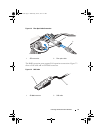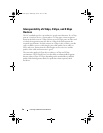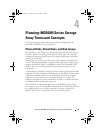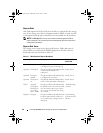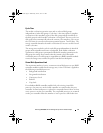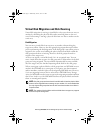
44 Planning: MD3600f Series Storage Array Terms and Concepts
RAID 0
RAID 0 uses disk striping to provide high data throughput, especially for large
files in an environment that requires no data redundancy. RAID 0 breaks the
data down into segments and writes each segment to a separate physical disk.
I/O performance is greatly improved by spreading the I/O load across many
physical disks. Although it offers the best performance of any RAID level,
RAID 0 lacks data redundancy. Choose this option only for non-critical data,
because failure of one physical disk results in the loss of all data. Examples of
RAID 0 applications include video editing, image editing, prepress
applications, or any application requiring high bandwidth.
RAID 1
RAID 1 uses disk mirroring so that data written to one physical disk is
simultaneously written to another physical disk. This RAID level offers fast
performance and the best data availability, but also the highest disk overhead.
RAID 1 is recommended for small databases or other applications that do not
require large capacity for example accounting, payroll, or financial
applications. RAID 1 provides full data redundancy.
RAID 5
RAID 5 uses parity and striping data across all physical disks (distributed
parity) to provide high data throughput and data redundancy, especially for
small random access. RAID 5 is a versatile RAID level and is suited for multi-
user environments where typical I/O size is small and there is a high
proportion of read activity such as file, application, database, web, e-mail,
news, and intranet servers.
RAID 6
RAID 6 is similar to RAID 5 but provides an additional parity disk for better
redundancy. RAID 6 is the most versatile RAID level and is suited for multi-
user environments where typical I/O size is small and there is a high
proportion of read activity. RAID 6 is recommended when large size physical
disks are used or large number of physical disks are used in a disk group.
book.book Page 44 Wednesday, June 8, 2011 5:01 PM




